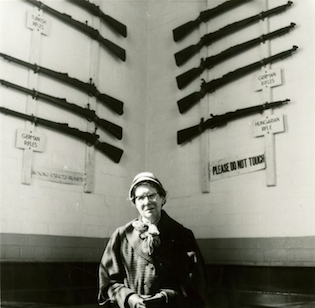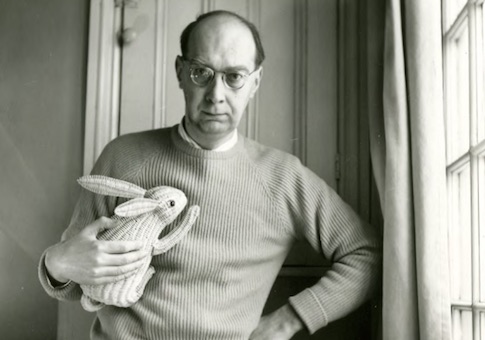In a poem he wrote in 1953 about perusing a photo album that belonged to Winifred Arnott—one of the many objects of his frequently anticlimactic erotic pursuits—Philip Larkin had this to say about the art of picture taking:
But o, photography! As no art is,
Faithful and disappointing! That records
Dull days as dull, and hold-it smiles as frauds,
And will not censor blemishes
Like washing-lines, and Hall’s-Distemper boards,
But shows a cat as disinclined, and shades
A chin as doubled when it is, what grace
Your candor thus confers upon her face!
How overwhelmingly persuades
That this is a real girl in a real place,
In every sense empirically true!
The narrator’s words are nonsense, of course—or at best true only in their most narrow, uninteresting sense. If you frame a photo such that it includes a washing-line and do nothing to manipulate the image, then you’ll indeed get a photo that includes a washing-line. But photography offers manifold opportunities for manipulation, in every sense.
So does poetry. Andrew Motion, Larkin’s first biographer, reported that Winifred provided a fact check for Larkin’s poetic license in a letter she wrote in 1986: "[T]here were in fact two albums not one, there’s not a picture of me wearing a trilby hat (though there is one of me in a beret and moustache for Rag Week). On the other hand, I’m afraid to see, there’s definitely my double chin, he got that right. And there’s also one of me bathing …"

That photo—tame by today’s standards, but sufficiently exciting for Larkin to joke sweatily in the poem, "So I am left … To wonder if you’d spot the theft/Of this one of you bathing …"—is included in The Importance of Elsewhere, a selection of Larkin’s photography (the poet was what you could call a "serious amateur") accompanied by biographical material by Richard Bradford. It is no overstatement to say that this selection is dominated by women, from Eva, the mother on whom Larkin doted, to the dizzying series of ladies he chased and occasionally even obtained. Besides Winifred, here we see Ruth and Jane, Patsy—a South African who happened to be married—Judy, Betty (Larkin’s longtime secretary), Maeve, and, of course, Monica Jones.
Larkin photographed them all, and there are some awkward implications conveyed here: Bradford illustrates how Monica, Patsy, and another woman as yet unidentified by scholarship were all snapped by Larkin in the room he rented in Belfast while working at Queen’s—and all in very similar poses. As in life, so in these photos: Monica is a considerable force. The longest serving of Larkin’s girlfriends, she carried on with him from his twenties to his final ambulance ride, despite numerous physical and emotional infidelities.
Loathed by Larkin’s intimate Kingsley Amis, who preferred ditzier girls who didn’t occupy his friend’s best attentions, she found herself cruelly (and unfairly) pilloried in Lucky Jim as the histrionic, louche Margaret Peel. But far from hysterical, Monica—Oxford educated like Phili, and a University lecturer in English—was devoted and possessed considerable character. She was also the only one of Larkin’s women who had the capacity to appreciate just what he was achieving.
It is remarkable that she also had the humanity to stress that none of those achievements were necessary grounds for her admiration. Consider this letter, included by Bradford, written by Monica after she heard Philip reading the bleak, ironic (evergreen commentary on a Larkin poem, that) Mr Bleaney on the BBC in 1955:
Mr Bleaney sounded so very like you – yr catalogue of the room’s shortcomings! Like you & like me – I smiled at the radio as if I were smiling at you as it was read. And I like your poetry better than any that I ever see – oh, I am sure that you are the one of this generation! I am sure you will make yr name! … Oh Philip – I don’t know what to say. You will believe me because you know it doesn’t make any difference to me whether you are or not, I shouldn’t think any less of your value if yr poems seemed to me bad & if everyone said so…
Monica’s presence in these photographs—intelligent, self-possessed, witty, often sad—gives some credit to Larkin’s line about "a real girl in a real place": she looks exactly as you would expect such a woman to look, and here one can see her grow from a young, newly appointed lecturer who has dressed for a date—and who has an obvious crush on her photographer—to a woman at the wrong end of middle age, wearing a house dress and staring out a window (something that comes up from time to time in Larkin’s poems) with a featureless expression.
For all the voyeuristic pleasures of these photographs, I can’t recommend putting too much trust in the commentary. Bradford’s control of detail in his earlier full-dress biography of Larkin was described by one critic at the time as "sketchy," and I cannot report that the situation is different here—nor does Bradford appear to have been much aided by his present editors.

The problems begin when the author of the book’s foreword is alternatively described as Mark Hayworth-Booth or Mark Haworth-Booth, depending on which page you happen to encounter his name. (I believe that the latter is correct.) Turning to the text itself, at one point Bradford says of Larkin, "He wrote in Further Requirements…" This is, at best, embarrassingly imprecise. Further Requirements, a collection of miscellaneous short prose, was published years after Larkin’s death; Bradford is referring to one piece included in that collection.
Such imprecision doesn’t inspire one to allow much benefit of the doubt when one sees, on pages that face one another, two photographs of Monica described as being taken three years apart, even though her hair, jewelry, glasses, and overall presentation appear to be identical. Finally, for a book about photographs taken by someone who, though an amateur, was nonetheless devoted to his hobby, it is nowhere clear that Bradford has anything to say about, well, photography.
The text is at its best when it directly treats the connections between the photographs and Larkin’s literary work, of which there are many: lonely churches and rail lines abound here. But too often the words seem meant to fill space, usually with information one could find in Bradford’s earlier book, or indeed in the more recent (and quite good) biography by James Booth. There is a really fine book to be got out of the relationship between Larkin’s photography and poetry. Someone should write it.
_
All photos are from The Importance of Elsewhere: Philip Larkin's Photographs / Copyright © Frances Lincoln Ltd 2015 / Photographs copyright © The Estate of Philip Larkin
